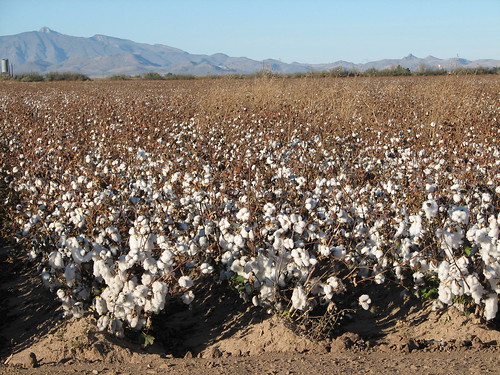February 2013
 |
| Cotton field. Picture by Aileen's Pics on Flickr |
Mexico is the centre of
origin of domesticated cotton. Clearly, steps to protect wild
cotton's natural diversification are critical for conservation and
future breeding.
Despite this, GM cotton has
been cultivated in the north of the country since 1996, and 21 gene
transformation events have been approved there (5,985 permits to sow
GM cotton were issued in the first 12 years).
Genes can escape through
pollen and seeds. Because cotton plants are mainly self-pollinating
and the two species grown commercially in the USA can't hybridise,
there's little opportunity for gene movement through pollen.
However, seeds have plenty of potential for dispersal: they survive
much longer than pollen and can be moved far and wide by water,
weather and birds; once the cotton fibre has been removed, the seeds
end up as truckloads of animal feed (on their way into the human
food-chain) travelling the highways.
In 2011, a paper was published on the movement of transgenes from biotech crops into wild populations of cotton in Mexico. Noting the “simplified and typically unrealistic population models” used to assess gene flow in previous studies, the authors used more sophisticated modelling based on landscape genetics.
Samples of wild cotton
plants were taken during 2002-2008, and tested for active expression
of common transgenes. Four transgenes were identified: three ''Bt'
insecticidal genes and one herbicide tolerance gene. Four out of
the eight populations sampled tested positive for GM protein. Of
these four, the three populations closest to GM cotton plots were
58.3-67.6% contaminated. The fourth, which was 755 kilometers from a
GM source was, surprisingly, 29.5% contaminated. These are very
significant levels of pollution.
It seems
that the initial spread of these transgenes occurred through seed
dispersal. After this, the artificial DNA has repeatedly recombined
during reproduction and spread through pollen.
Ominously, some plants had
stacked events not contained in any commercially available event, and
one plant was found to be expressing all four artificial genes.
This indicates that the original
transgenic events are being altered in the wild in unpredictable
ways. It also means that the researchers will have underestimated
the extent of the pollution, because they were only looking for
intact genes which were actually expressing themselves. Rogue
artificial DNA which is not producing a protein in the plant, but
could nevertheless interfere with the healthy functioning of its
natural DNA, wasn't sought, and may even form the bulk of wild
cotton's actual genetic pollution.
The
conclusion reached was that self-pollination and geographical
barriers hinder, but can't prevent, gene flow: the invaluable wild
germ-plasm of cotton in Mexico is in danger.
Is the
risk of compromising our future access to a huge wild-cotton
gene-pool, that should be the heritage of future generations, worth
it?
In
India, policy makers would say 'yes' to this question. They have
hailed Bt cotton as a success story. But Greenpeace has a different
version. The 'success' of the GM cotton has been brought about by
“fake farmers” vouching for GM cotton crops they never grew and
by persuasive local promotions that have lured many real farmers into
using the high-priced GM seed and agrichemicals needed. This
has turned, for many, into a debt-trap in which some farmers have
been driven to suicide.
At the start of 2012,
advertisements placed by Monsanto India in a major newspaper claiming
that “Bollgard (GM cotton) boosts Indian cotton farmers'
income by over Rs31,500 crores” were found by the Advertising
Standards Council of India to be 'not substantiated'.
By March 2012, the Indian
media were reporting that:
“India's Bt cotton dream is going terribly wrong ... Cotton farmers are in deep crisis since shifting to Bt cotton ... Bt cotton's success, it appears, lasted merely five years. Since then, yields have been falling and pest attacks going up” (Zia Haq).
By November 2012, even the
state government in India's largest cotton-growing area was admitting
that yields of Bt cotton were down 40%. The problem has been
severely exacerbated by rising prices for GM seed, fertiliser,
pesticides and labour. Farmer suicides in this state have been
officially reported as up by 43% (Note that the actual figure may
be much higher).
OUR
COMMENT
There
seem to be an awful lot of GM cotton plants right in the middle of
our future genetic resources: this is the last place we want them.
And there seem to be far too few GM cotton plants in Indian farmers'
fields: where people's lives and livelihoods are dependent on them:.
The
story of cotton may well herald the shape of things to come: imagine
your food-supply caught in a wild GM maze it can't get out of, with
crop failures at every second turn?
On the
subject of gene pollution, check out WHY 'CO-EXISTENCE' IS IMPOSSIBLE - January 2013.
SOURCES:
- A Wegier, et al., 2011, Recent long-distance transgene flow into wild populations conforms to historical patterns of gene flow in cotton (Gossypium hirsutum) at its centre of origin, Molecular Ecology, 20
- Yogesh Pawar, Bt failure to hit cotton yield by 40%: Govt, Daily News and Analysis, www.dnaindia.com, 26.11.12
- Rachna Arora, Advertising Standards Council of India concludes Mahyco Monsanto Biotech's claims on Bollgard are unsubstantiated, Public Awareness on Genetically Modified Foods, 12.01.12
- Zia Haq, Ministry blames Bt cotton for farmer suicides, Hindustan Times, 26.13.12
- The marketing of Bt cotton in India - aggressive unscrupulous and false, Greenpeace 20 .09.05
- Sandeep Pai & Sudhir Suryavashi, Marathwada region beats Vidarbha in farmer deaths, Daily New Analuysis, www.dnaindia.com, 3.03.12
- Ashish Roy, Hard truths come to fore before panel, Times of India, 3.03.12
No comments:
Post a Comment
Thanks for your comment. All comments are moderated before they are published.